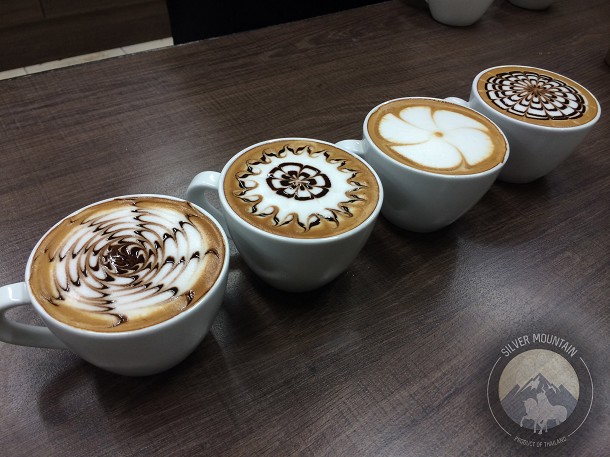Have You Ever Wondered what Makes the Difference to the Taste of Coffee?
There are several reasons:
Climatic condition.
There are several types of coffee, but the two popular types are arabica and Robusta. There are two optimal growing climates for arabica. For the subtropical area, the arabica should be grown in rainy and dry seasons with the altitude around 1800-3600 feet. Mexico, Jamaica, some parts of Brazil, and Zimbabwe are examples of areas with these climate conditions. Equatorial regions such as Kenya, Colombia, Ethiopia, Thailand and Laos usually have frequent rainfall, and with the use of an artificial dryer, these regions can have two harvesting seasons and the altitude needs to be around 3600-6300 feet. Robusta coffee can be grown at lower altitudes of around sea level to 3000 feet, and Robusta is more tolerant to hot temperatures than Arabica. For examples, Thailand is one of the perfect countries, which can be grown both Arabica and Robusta. the areas of heavy rainfall and higher elevation are required to produce the Arabica plant, so the hill in northern Thailand are suitable. Also, most of the Arabica beans commonly grown in the Chiang Mai and Chiang Rai province in the north of Thailand with an elevation range of 800 metres to 1,200 metres above the sea level. The local people control the majority of the farm. They usually grow coffee along with other fruit trees. The environment affects the minerals in the soil, and bees help to spread the pollen of the fruit trees to the coffee flowers, all contribute to making Thai coffee special. While Robusta coffee also popular in Thailand, the local farm in southern Thailand can produce 80,000 tonnes each year.

Harvesting factors
The harvesting process is essential because it affects the quality of the coffee. Green or half-ripe coffee would negatively affect the taste. Fully ripe is the best which will bring out the full quality of the coffee. Harvesting the ripe cherries can be done by hand or machine. To select the best quality, hand picking instead of using a machine is better because the harvester can leave the unripe or half-ripe cherries for further harvesting by machine. Some of the coffee farms in Thailand only harvest cherries by hand, which make them able to select the best quality.
The coffee roasting process
The raw coffee beans are soft, with a fresh smell and have less taste, and the roasting process is essential as it enhances the aroma and flavour of the beans. Different types of coffee, age or origin are likely to taste different even when roasted to the same level, and the colour of the roasted beans can describe the roast levels, ranging from light to dark, the more heat the beans absorb in the roasting process, the more the colour becomes darker. There are some differences between light and dark roasts. Firstly, the darker roasted coffee loses the origin flavour of its beans and takes on more character from the roasting process .On the other hand, Lighter roasts have more acidity, and it can taste sourer than darker roasts. Secondly, lightly roasted coffee beans are dryer than the darker roasts and the darker roasts can have oil on the beans. Darker coffee also has less caffeine than light coffee. The beans need to be kept in a dry place and away from heat, light and air. The coffee can begin to lose it freshness after the roasting process so it is not a good idea to store a huge amount of roasted coffee in your kitchen because it can quickly lose the quality once the packaging seal has been opened.
 Coffee Grinding
Coffee Grinding
The step before the final brew, the perfect filter, coffee beans and an expensive machine can’t help if you don’t you which level of grind is perfect for you. The primary goal of grinding coffee is to break the roasted bean and allow the water to meet every part of the coffee, which extracts the flavour of the coffee. The level of grinding depends on your brewing method, but if you brew coffee that is ground too coarse, the coffee can have less flavour. But if it is too fine the coffee can be over-extracted and bitter. The coarse ground is goes well with a French press, medium and fine ground are good with a drip coffee maker — finally, the extra-finely ground beans need to be used by a coffee machine with a steam or pump.
 One of the best brewing methods is Drip coffee, which provides the full aroma taste as similar as brewing machine. It only required some small items with process of pouring hot water through the filter. The drip coffee bag is new innovation package of filter bag coffee, becomes popular in Asia by its ability to maintain the quality of the taste with less step to make when compared to other ways of making fresh coffee. You only need to select the size of the cup matches your preferences and enjoy pouring hot water through filter bags.
One of the best brewing methods is Drip coffee, which provides the full aroma taste as similar as brewing machine. It only required some small items with process of pouring hot water through the filter. The drip coffee bag is new innovation package of filter bag coffee, becomes popular in Asia by its ability to maintain the quality of the taste with less step to make when compared to other ways of making fresh coffee. You only need to select the size of the cup matches your preferences and enjoy pouring hot water through filter bags.
Climatic condition.
There are several types of coffee, but the two popular types are arabica and Robusta. There are two optimal growing climates for arabica. For the subtropical area, the arabica should be grown in rainy and dry seasons with the altitude around 1800-3600 feet. Mexico, Jamaica, some parts of Brazil, and Zimbabwe are examples of areas with these climate conditions. Equatorial regions such as Kenya, Colombia, Ethiopia, Thailand and Laos usually have frequent rainfall, and with the use of an artificial dryer, these regions can have two harvesting seasons and the altitude needs to be around 3600-6300 feet. Robusta coffee can be grown at lower altitudes of around sea level to 3000 feet, and Robusta is more tolerant to hot temperatures than Arabica. For examples, Thailand is one of the perfect countries, which can be grown both Arabica and Robusta. the areas of heavy rainfall and higher elevation are required to produce the Arabica plant, so the hill in northern Thailand are suitable. Also, most of the Arabica beans commonly grown in the Chiang Mai and Chiang Rai province in the north of Thailand with an elevation range of 800 metres to 1,200 metres above the sea level. The local people control the majority of the farm. They usually grow coffee along with other fruit trees. The environment affects the minerals in the soil, and bees help to spread the pollen of the fruit trees to the coffee flowers, all contribute to making Thai coffee special. While Robusta coffee also popular in Thailand, the local farm in southern Thailand can produce 80,000 tonnes each year.
Harvesting factors
The harvesting process is essential because it affects the quality of the coffee. Green or half-ripe coffee would negatively affect the taste. Fully ripe is the best which will bring out the full quality of the coffee. Harvesting the ripe cherries can be done by hand or machine. To select the best quality, hand picking instead of using a machine is better because the harvester can leave the unripe or half-ripe cherries for further harvesting by machine. Some of the coffee farms in Thailand only harvest cherries by hand, which make them able to select the best quality.
The coffee roasting process
The raw coffee beans are soft, with a fresh smell and have less taste, and the roasting process is essential as it enhances the aroma and flavour of the beans. Different types of coffee, age or origin are likely to taste different even when roasted to the same level, and the colour of the roasted beans can describe the roast levels, ranging from light to dark, the more heat the beans absorb in the roasting process, the more the colour becomes darker. There are some differences between light and dark roasts. Firstly, the darker roasted coffee loses the origin flavour of its beans and takes on more character from the roasting process .On the other hand, Lighter roasts have more acidity, and it can taste sourer than darker roasts. Secondly, lightly roasted coffee beans are dryer than the darker roasts and the darker roasts can have oil on the beans. Darker coffee also has less caffeine than light coffee. The beans need to be kept in a dry place and away from heat, light and air. The coffee can begin to lose it freshness after the roasting process so it is not a good idea to store a huge amount of roasted coffee in your kitchen because it can quickly lose the quality once the packaging seal has been opened.
The step before the final brew, the perfect filter, coffee beans and an expensive machine can’t help if you don’t you which level of grind is perfect for you. The primary goal of grinding coffee is to break the roasted bean and allow the water to meet every part of the coffee, which extracts the flavour of the coffee. The level of grinding depends on your brewing method, but if you brew coffee that is ground too coarse, the coffee can have less flavour. But if it is too fine the coffee can be over-extracted and bitter. The coarse ground is goes well with a French press, medium and fine ground are good with a drip coffee maker — finally, the extra-finely ground beans need to be used by a coffee machine with a steam or pump.
Some tips for drip coffee: you can choose to pour less water for a strong brew, or pour in a little more for a lighter taste. For an average cup like this (pic) we recommend you to pour the hot water until it reaches the edge of the filter bag and waits for the coffee to seep out the filter. Follow this step twice. Then you can enjoy your perfect cup of coffee.
Get in touch: Silvermountain
silvermountain999.com
INSTAGRAM
FACEBOOK
Get in touch: Silvermountain
silvermountain999.com











